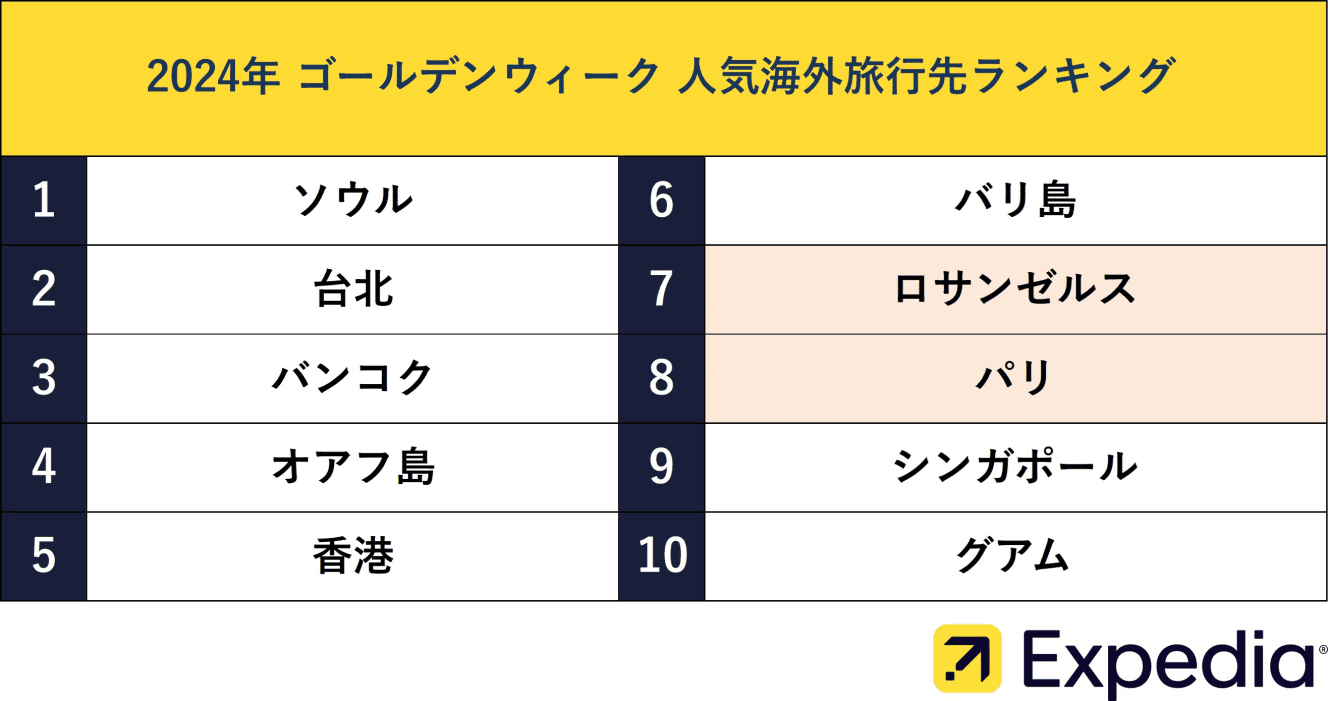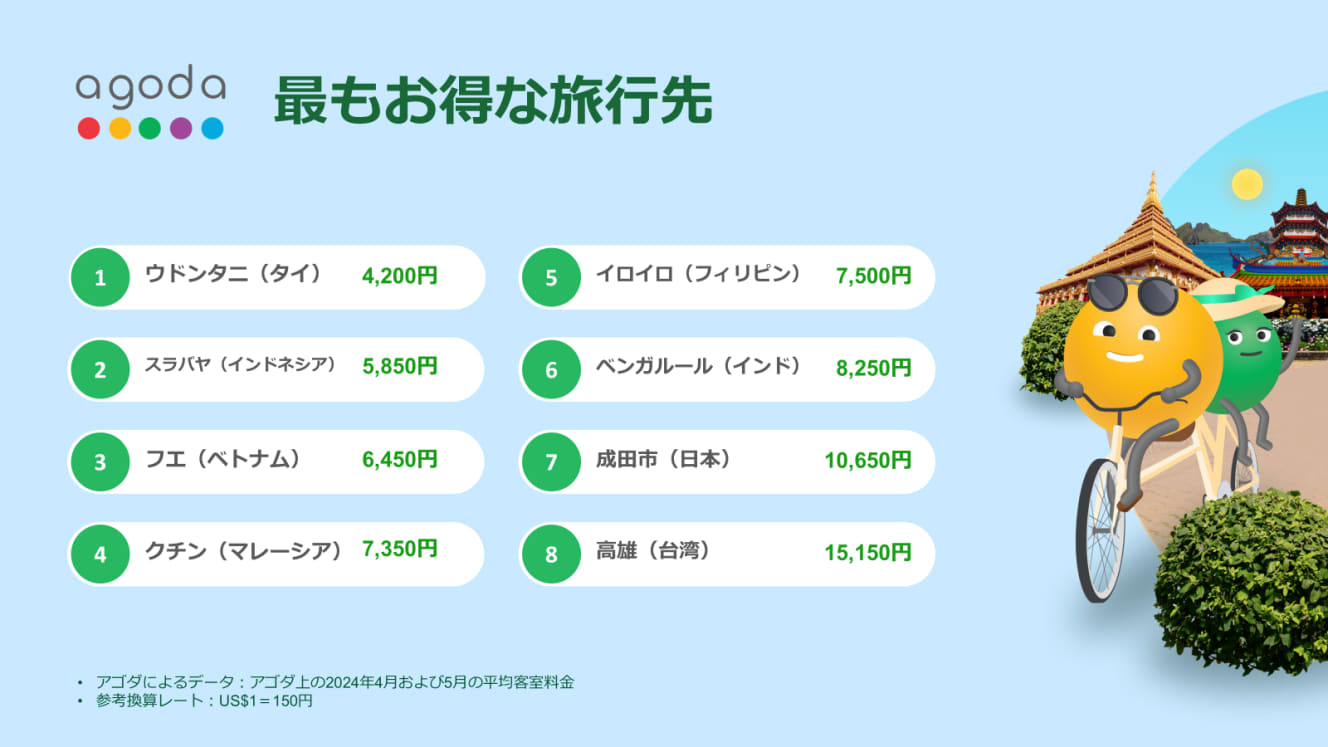Japanese Overseas Travel Faces Prolonged Downturn as Yen Weakens During Golden Week
Up to 10 consecutive holidays for GW 2024, but the yen’s depreciation will not stop
After the new Corona, demand for inbound travel to Japan is increasing rapidly. On the other hand, the number of Japanese traveling abroad remains sluggish and the number of outbound travelers is still less than half of the pre-Corona level, far from a recovery. The main reasons for this are the yen’s depreciation to over 150 yen to the dollar, persistently high airfares, and high local prices.

Nevertheless, the time for major holidays (Golden Week, GW) will soon arrive. In 2024, it will be from April 27 (Saturday) to May 6 (Monday), and if you take off the middle weekday from April 30 (Tuesday) to May 2 (Thursday), you will have 10 consecutive holidays.
Major travel agencies recently announced GW travel reservation trends. We interviewed travel industry experts to find out which are the most popular destinations for international travel, recommended countries and regions with low travel costs, and future prospects.
Major Travel Agencies’ GW Outlook, Overseas Travel Popularity Ranking and Analysis
In early April, JTB released its outlook for GW travel trends. Based on various economic trends and a questionnaire survey conducted by the JTB Group, the number of overseas travelers is estimated at 520,000 (167.7% of the previous year), the average cost at 269,000 yen (104.7% of the previous year), and travel expenditures at 139.9 billion yen (175.6% of the previous year).
Regarding these results, “The number of travelers recovered to 80-90% of the level before the outbreak of the new coronavirus infection (excluding 2019, when there were 10 consecutive holidays). The analysis also noted that the average travel cost (unit price) is expected to rise due to the weak yen and high prices, and that travelers are highly motivated to travel, but due to the high cost of travel, many are choosing nearby destinations, especially in Asia,” among other factors.

The top five destinations were (1) South Korea, (2) Southeast Asia, (3) Taiwan, (4) the U.S. mainland and Canada, and (5) others. Europe, which ranked second in pre-Corona ’19, and Hawaii, which ranked third, have dropped down the rankings.
HIS also announced travel reservation trends for those who applied for its tours and airline tickets. The YoY change in the number of bookings was 123.2%, and 53.3% compared to the same period in 2018 before Corona. The average unit price was 204,900 yen, 98.5% of the same period last year (147.7% of the same period in 2018). The ranking by number of bookings was (1) Seoul, (2) Taipei, (3) Honolulu, (4) Bangkok, and (5) Busan (Busan).

Hankyu Express also recently released a summary of travel trends for overseas and domestic travel based on GW reservations. The results were (1) Europe, (2) Taiwan, and (3) South Korea. Hankyu Express noted that “Demand for Asia, including South Korea, has been increasing since last year, and this trend is also noticeable during Golden Week,” but also analyzed that Europe, where travelers can easily take longer vacations, especially repeat visitors, for longer periods of time and at reasonable prices, is also popular during Golden Week. The number of European travelers who are able to take longer vacations, especially repeat visitors, are also popular during the Golden Week holiday season.

Meanwhile, Expedia Japan, a major foreign OTA, announced the following ranking of popular overseas travel destinations for GW. The ranking is based on the number of searches during the GW season, not the actual number of reservations.

Based on the number of searches, demand for overseas travel is on the rise this GW, up 136% from last year. Seoul, Taipei, Bangkok, Oahu (Honolulu), and Hong Kong ranked high, with six of the top 10 destinations in Asia.
The trend of near Japan is similar to that of JTB and HIS. Los Angeles is likely to be the site of the Major League Baseball tournament, while Paris is likely to be the site of this summer’s Olympic Games.
The Top 8 Surprisingly “Affordable” Travel Destinations in Nearby Asian Countries
All of the rankings indicate that Korea and Taiwan, which are close to Japan, are the most popular destinations for GW this year. The airfares can be kept low when they are close by. Although the recent depreciation of the yen and high local prices have made them more expensive than before Corona, they are less burdensome in terms of travel costs than Europe and the United States.
On the other hand, there are also a number of other overseas destinations that can be visited at a lower cost.

Agoda, a major foreign OTA company, recently announced the “Destinations with the Most Reasonable Average Room Rates” for the months of April and May. The top eight destinations were: 1) Udon Thani (Thailand), 2) Surabaya (Indonesia), 3) Hue (Vietnam), 4) Kuching (Malaysia), 5) Iloilo (Philippines), 6) Bengaluru (India), 7) Narita City (Japan), and 8) Kaohsiung (Taiwan).
For example, Udon Thani is one of the four largest cities in the Issan region, located near the border with Laos, and is home to many prehistoric ruins that are rare in Thailand. Surabaya is Indonesia’s second largest city and home to one of the top zoos in Southeast Asia, as well as local markets and traditional cuisine. Hue, Vietnam, is an ancient city that prospered as the capital of the Nguyen Dynasty. The royal palace and temples in the old city are registered as a UNESCO World Heritage site, and boat cruises on the Phuong River are very popular. Bengaluru in India and Kaohsiung in Taiwan are cities with direct flights from Japan.

In many countries and regions, if you avoid the capital city and go to the countryside, you will find that the cost of living, including hotel expenses, is lower. If accommodation costs can be reduced, it can also lead to savings on overall travel expenses. In countries such as Vietnam and Indonesia, local prices have risen slightly since before the corona due to the depreciation of the yen, but they are still less expensive than in Japan.
Japanese Traveling Abroad, National Data Shows Harsh Reality
According to preliminary figures released by the Immigration and Residency Management Agency, the number of Japanese departing Japan in Reiwa 2023 was 9,624,152, compared to 8,086,669 in Reiwa 2019, the year before Corona. In other words, the number of immigrants to Japan is less than half the number before Corona.
According to data from the Ministry of Foreign Affairs, the number of valid passports at the end of 2011 was 2,064,745, which is only 17.0% of the total number of Japanese citizens. Compared to 23.8% in 1919, the rate has been declining ever since the COVID-19 crisis.

The Japanese passport has long been internationally known as the “world’s strongest passport” because it allows entry into many countries without the need for a tourist visa. However, the yen has weakened, local prices have risen, and the cost of staying in Japan has increased far beyond what it was before the Corona. The passport renewal fee for a 10-year passport is not cheap at all, at 16,000 yen, and it is a fact that not a small number of people are actually taking a wait-and-see attitude toward overseas travel.
The editor-in-chief of a travel industry newspaper says, “It will be tough for a while, but interest is high.”
Travel agencies are receiving an increasing number of inquiries about overseas travel, and interest in overseas travel itself remains high. Kazuyuki Tomimoto, editor-in-chief of “Travel News at,” a newspaper specializing in tourism and travel, said, “The main destination now is Asia. However, we often hear that tour prices are more expensive than before, with fuel surcharges higher than the cost of airline tickets, and that it is difficult to explain this to customers.
Regarding this year’s GW and the future, he said, “The market for overseas travel is still tight, and we have not seen a big wave. The recent situation suggests that there will not be a sudden increase in overseas travel by Japanese people for some time to come. However, many travel agencies believe that in the long term, there will be a gradual return,” he said.
Furthermore, the number of customers visiting travel agency counters is increasing, not only for consultation before Corona, but also to make immediate decisions on tours, airlines, hotels, etc. on the spot after doing research beforehand. It seems that Japanese people’s overseas travel and their travel style itself are changing.
Interview and text: Aki Shikama / Aki Shikama PHOTO: Afro
